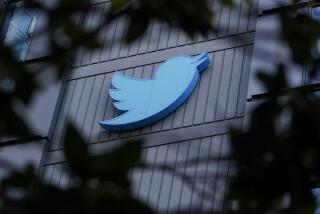Twitter as a car marketing tool
- Share via
You’ve used the Internet to do research on your new car and to find the value of your old one, and you’ve visited online fan sites and notice boards to get the most out of your shiny new ride. But have you tracked a new-car launch or auto product on Twitter?
Car companies are increasingly using the seemingly ubiquitous Twitter to inform and engage potential and existing customers. But will the bold new experiment in social media work? Is the Twitter audience particularly receptive to overtures from auto companies? And what does it mean for the future of digital marketing?
Volvo recently used Twitter as part of a coordinated media strategy to launch its XC60 crossover, while Land Rover tweeted about its product line at this year’s New York International Auto Show.
And General Motors Corp. and Ford Motor Co. are longtime Twitter users in areas including customer service and product launches.
Basically, Twitter allows a company executive or marketing team to engage an online audience that has chosen to follow short, rapid-fire updates, or tweets, on the company’s latest developments.
The strategy is a boon for carmakers, said Andy Sernovitz, author of “Word of Mouth Marketing,” because it gives a company direct access to an audience that has indicated it wants to receive information.
“Twitter is a bunch of people who are asking to hear from you, and that’s wonderfully powerful,” Sernovitz said. “They’re asking for the information and they want to share it with their friends.”
Ford’s global digital and multimedia communications manager, Scott Monty, said the company had been using Twitter since last July and now had about 30,000 followers across 12 subject areas.
“We’re using it in day-to-day communications in terms of interacting with people, solving vehicle-related problems, sharing corporate news and live tweeting from events and auto shows,” he said.
Ford’s more popular feeds, he said, include information on its Drive Green program and its Mustang model. The company recently launched a bilingual feed in English and Spanish.
GM runs a corporate blog and has more than 40 of its employees using Twitter. The social media website has allowed GM to connect with and respond to consumers during its recent troubled times.
“We have a lot of answering to do in general with what’s going on with the company. We did a whole lot of tweeting during the Chapter 11. People have questions; they want to know what’s going on. We’re their ears,” said Christopher Barger, GM’s director of global communications technology.
“Twitter allows us to get back to one-to-one sales, winning people’s trust back one by one,” he said. “It’s a way to give individual attention, and we need these one-to-one interactions.”
Volvo, meanwhile, first experimented with Twitter by posting a feed from its chief executive and president of the automaker’s North American unit, Doug Speck, which put extra pressure on its communications team, said Geno Effler, the unit’s vice president of public affairs.
“We helped condense his sentences down to 140 characters. It helped him connect with consumers,” Effler said. “We found it to be very worthwhile to talk about the XC60 as it was coming to market, to answer basic questions about the car or about safety, and convey the information in very short spurts.”
He said Volvo was “still a neophyte” in social networking but was curious about Twitter.
“It’s all about getting connected and keeping connected with our owners,” he said. “As a customer, the more you feel about being part of the team, the more loyal you become to that company or that brand.”
Alexandre Acey, communications manager at Land Rover North America, said the company used Twitter as part of a coordinated media strategy that included posting tweets on those little information screens you sometimes see in elevators and on similar screens in taxi cabs to spread the word about launches of its models, including Range Rover, Range Rover Sport and the new LR4.
Acey said the Twitter strategy cost the company less than $1,000, most of it in agency fees, compared with a national TV ad campaign, which can run into millions of dollars.
“We encouraged our audience to contribute to the conversation,” he said. “It’s a great medium to get the word out. Going forward we’ll evaluate it, perhaps when a new product comes down the line.”
Sernovitz said he had seen a surge in the number of major companies using Twitter to market their products but said that a company should be wary of breaching several important Web protocols and must send out a frequent stream of information or its audience might lose interest. Another issue to decide: who in the company will be on Twitter.
“Always be honest about who you are,” Sernovitz said. “Never pay for it; if you do, you’ll always be caught and embarrassed. And use common sense: If something seems at all pushy or intrusive, then you’ve gone too far.”
--






